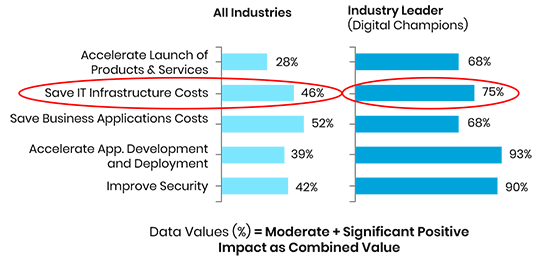The cloud presents a paradigm shift in enterprise computing. Where on-prem infrastructure is restrictive and complex to manage, the cloud unlocks a whole new world of possibilities through scalability and simplified operations management, where server infrastructure can adapt alongside your business.
As compared to traditional on-prem infrastructure, the cloud delivers substantial cost benefits at scale at the enterprise level. Its real-time analytics, virtual R&D, and design capabilities help accelerate new product/service and internal IT application launches.
Optimizing cloud costs will yield better results if organizations think strategically and establish strong processes to stay on track. But there are a lot of service-specific steps they can undertake to get their budget under control. Trianz has developed a unique approach to align with its clients no matter where they are in their cloud adoption journey.

The key steps in this cloud assessment phase include:
A focus on detailed migration strategy and identification of all dependencies
A scorecard to help strategize, architect and map application landscape to cloud services
Guidance to develop a Total Cost of Ownership and Return on Investment plan
Cloud Optimization Is a Fundamental Driver for Investment Among All Industries And Industry Leaders
Cloud adoption has begun to demonstrate cost-saving benefits on IT infrastructure and business applications across all industries. Our data suggest that digital champions (the companies who have found the most success in their digital transformations) see even higher benefits in time-to-market for products/services and cybersecurity due to enterprise-wide initiatives.
Cost Optimization as a Driver for Investment

Source: Trasers(Trianz Research)
Our Approach to Cloud Optimization and Strategy
As part of our strategic execution analysis, Trianz takes a comprehensive approach to analyzing a client’s readiness for the migration of applications to a public or private cloud infrastructure.
We recognize that every cloud migration assessment and strategy must begin by gathering the right information from your business units. This step of our framework includes conducting a current-state analysis, and further refinement and assessment to ensure the application portfolio meets the fundamental evaluation criteria.
We work with clients to help them:
Define strategic objectives
Create a cloud council, detailed technology, and execution roadmap
Gain cross-functional companywide buy-in
Undertake financial planning
Accurately estimate cost(s) for solutions
Evaluate application and processes for migration (as-is-recoding)
Understand issues related to public cloud, security, governance, risk, and compliance
And we don’t stop there. Our cloud strategy services specialists recommend a best-in-breed architecture to make your ‘cloud-first’ strategy implementation a resounding success.

















